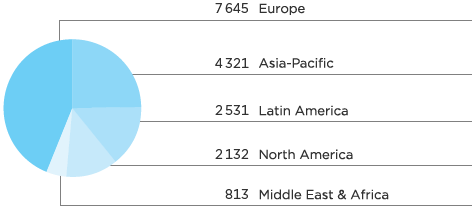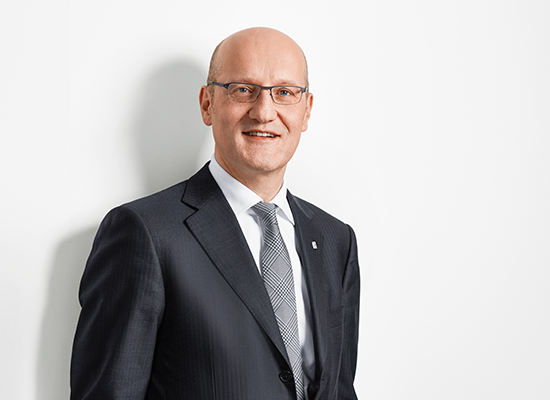Empowering and equipping all employees at every level to create value for the company and its stakeholders are essential to success in the marketplace. Clariant’s human resources practices, such as recruiting, learning, or performance management, are all designed to support the implementation of Clariant’s business strategy.
Enabling leading performance
18%Global Management
18% of employees in Management Level 1 – 5 are from emerging countries.
Clariant is striving to build a reputation as a preferred employer to attract, engage, and retain the right people on its journey toward a high-performing company. In 2016, Clariant hired 1 675 new employees (581 women and 1 094 men) to support this profitable growth strategy. During the same period, 629 women and 1 269 men left the organization. 38% of new hires were in high-growth economies (Asia/Pacific and North America). In order to achieve this scale of growth and to successfully attract top global talent, Clariant changed the way it approaches recruitment. The new Global Recruitment Model delivers a more dedicated, targeted and cost effective way to attract and source high caliber talent in the Regions, while also optimizing our employer-branding efforts in these important locations.
To prepare for success and boost performance, Clariant has focused its activities in 2016 on enabling leading performance through best-in-class, cloud-based »MySuccess – Solutions for People« that integrate all people-related processes. It enables managers and employees to contribute successfully to company performance and further develop their skills and expertise. This is supported by easy access to HR data and HR processes and by opening up new ways of interacting within the Group at all levels, including a new global internal job board that gives all employees the opportunity to view, apply for, or refer friends to one of Clariant’s exciting job offers. As a next level of self-service, a new core HR digital solution system »EmployeeCentral@Clariant« is currently beeing created as the single global source of HR records and key workforce data. It allows the company to accelerate HR efficiency by streamlining and simplifying HR processes through a globally harmonized application landscape.
in full time equivalents (FTE) or headcount (heads) as indicated |
2016 |
2015 |
||||||||||||
|
||||||||||||||
Total Staff (FTE) |
17 442 |
17 213 |
||||||||||||
Global Management1 (FTE) |
814 |
817 |
||||||||||||
Women in Global Management1 (FTE) |
114 |
104 |
||||||||||||
Men in Global Management1 (FTE) |
700 |
713 |
||||||||||||
General Staff2 (FTE) |
16 628 |
16 396 |
||||||||||||
Women in General Staff2 (FTE) |
3 599 |
3 652 |
||||||||||||
Men in General Staff2 (FTE) |
13 029 |
12 744 |
||||||||||||
Turnover rate3 |
10.7% |
10.4% |
||||||||||||
Participants (heads) in 360 degree feedbacks (ML 1- 5 +) |
975 |
1 050 |
||||||||||||
Staff (heads) participated in performance dialogs |
9 000 |
7 880 |
||||||||||||
Total training hours |
201 884 |
182 3984 |
||||||||||||
Training hours per participant (heads) |
19 |
20 |
||||||||||||
Personnel expenditures in m CHF5 |
1 383 |
1 345 |
||||||||||||
Focus on engagement, performance management and diversity
90Diversity
People from more than 90 nations form a diverse workforce.
Since attracting and retaining engaged and motivated employees is vital for Clariant to achieve its goal of leadership and sustainable profitable growth, in November 2016, Clariant conducted its second employee engagement survey. 15 803 employees in 26 countries were invited to participate in 18 languages, corresponding to almost 90% of the global workforce, and 69% of those invited or nearly 11 000 employees took part. First results show that Clariant has significantly increased its engagement score and is steadily closing the gap to the global chemistry benchmark. In Latin America and selective SEAP countries, engagement scores are already above the country benchmark. Next steps will be to further analyze, understand, share and discuss results as well as to prioritize issues and plan actions including the monitoring of progress and communication.
FTE by Region
Total Staff 17 442

An improved performance management tool as a key component of employee engagement and increased attention for a diverse workforce complements Clariant’s approach to tackling the ongoing change agenda for a high-performing organization. Clariant employees represent more than 90 nationalities and 44% of staff works in emerging markets. Across the organization, diversity is lived to ultimately ensure a strong customer service mind-set and triggers organizational growth worldwide. The thought diversity, which is created by the differences among the employee population, enhances creativity and innovation. To Clariant, promoting diversity is not just a policy – it is closely linked to the overall organizational strategy.

Michael Riedel Head of Group Human Resources»Expectations of high performance, a unique excellence approach, and opportunities to drive change and create value in a respectful, open-minded environment are key elements to position Clariant as a preferred employer.«
Empowerment through training and development
People Excellence embodies Clariant’s philosophy for leading people and translates business strategies into relevant people initiatives. A People Excellence strategy defines the capabilities, skills and mind-set needed to successfully execute a strategy – across the entire organization.
People Excellence contains the elements »Leadership Development«, »Culture and Engagement«, »Talent Management«, and »Learning and Capability Building«.In addition, People Excellence ensures that all Recruitment and Performance Management actions are closely linked to Talent Management and current and future organizational requirements.

Klementina Pejic Head of Senior Management Development»Clariant’s People Excellence programs and initiatives strengthen consistent leadership behaviors and management practices across the organization.«
Investing in Leadership Development
Demonstrating People Excellence in practice starts with our leaders in the organization – the way how they behave and how they lead and motivate their teams. During the past few years we have systematically defined competency requirements for all key positions to successfully implement strategies. Key position holders are being evaluated in a structured process, receive a factual feedback and benefit from customized learning measures to develop their capabilities.
Culture and Engagement enable strong results
A culture has to be proactively shaped and supported by lean and aligned leadership practices. Continuous learning and development are key pillars for all our employees to keep pace with the changing requirements and the increasing pace in the market. Clariant aims to create a high performance culture where leaders inspire and mobilize their teams and the entire organization with their passion for renewal and thus believe and strive for maximum performance in the company. We offer diverse programs to maximize individual, team and organizational performance.
Talent Management – positioning the company for the future
Today the business environment is highly dynamic – the way to do the job is constantly changing. For continuous success, individuals have to consistently develop new skills to meet the demands of the marketplace. This can be achieved most effectively in the context of business situations directly relevant for the company, which is why cultivating talents internally is often more sustainable than recruiting talents from outside the organization.
We have created a structured approach to Talent Management that links together business strategy, role requirements, recruitment, capability development and performance management. This allows us to effectively attract, identify and develop high quality internal candidates for our leadership positions. Today we have more than 1 000 talents in the local, regional and global talent pools that are being systematically developed for broader roles. At Clariant, we have successfully filled more than 85% of our senior management positions since 2012 with internal talent.
The key pillars in Talent Management are first to understand the right criteria for candidate selection and properly identify employee’s future development potential. Implementing a system to develop talents and to measure the impact of leaders in the organization form the second pillar of Talent Management. Making sure that talents are deployed effectively is the third pillar in order to motivate and retain talents in the organization.
Learning & Capability Building – empowerment through learning
One of the key components in Clariant’s People Excellence strategy is to offer tailored learning initiatives designed to improve competencies and strengthen individual performance. Clariant empowers its employees to constantly develop themselves through a wide range of learning opportunities. The Clariant Learning & Academy team uses the annual learning needs analysis to identify organizational and individual learning needs and adjust the training courses accordingly.
Stakeholders are people or groups whose interests are linked in various ways with those of a company. They include shareholders, business partners, employees, neighbors, and the community. VIEW ENTIRE GLOSSARY
